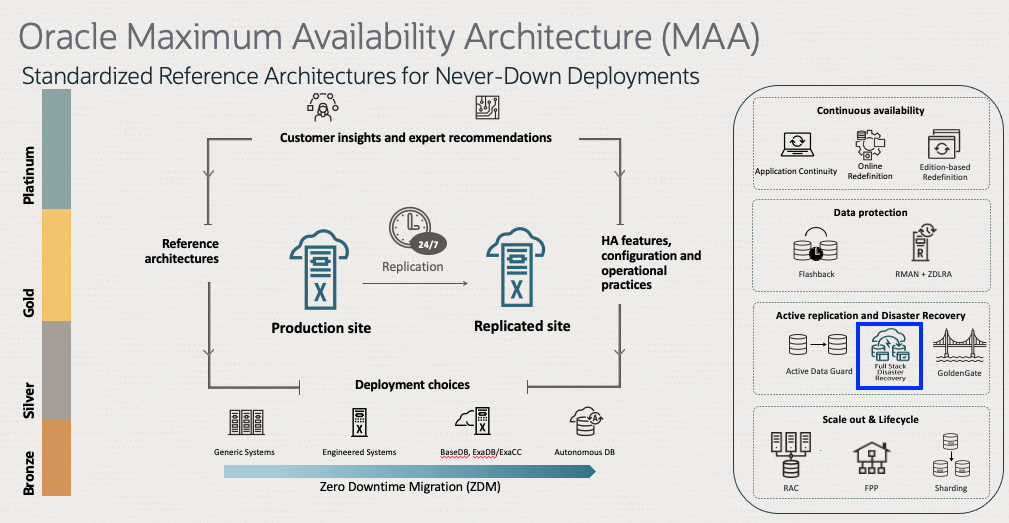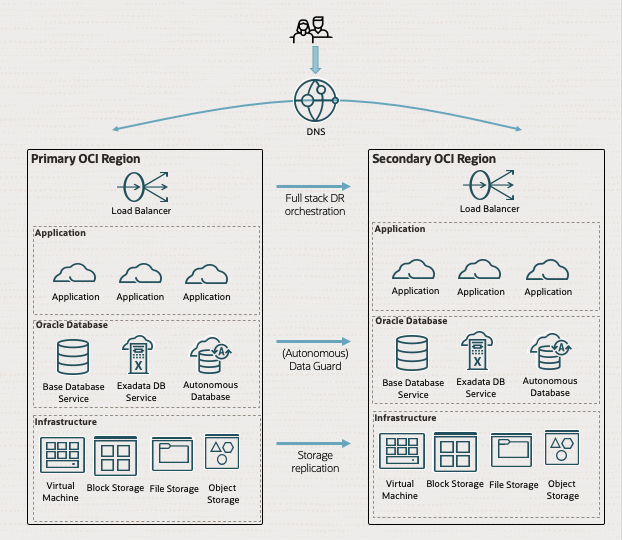Earlier this year, we announced the beta program for OCI Full Stack Disaster Recovery. I am now thrilled to announce the general availability of OCI Full Stack Disaster Recovery. Full Stack Disaster Recovery (Full Stack DR) orchestrates the transition of infrastructure, platforms, and applications between OCI regions from around the globe with a single click. Switchover or failover events can be handled in the context of a controlled role transition or disaster recovery (DR) event from the primary to the secondary region.
Disaster Recovery Challenges:
These are some of the common challenges customers face in managing disaster recovery:
- Increasing complexity
- Modern applications often have multiple interdependent components and services deployed across shared and dedicated infrastructure, making DR orchestration difficult.
- Manual scripts and jobs are problematic.
- Existing operations tend to involve manual processes and are often error-prone, unreliable, time-consuming, and require specialized skill sets.
OCI Full Stack Disaster Recovery (Full Stack DR) strengthens Oracle Maximum Availability Architecture:
Modern applications and databases need uninterrupted availability to ensure business continuity during unplanned outages and planned maintenance events. Oracle Maximum Availability Architecture (MAA) provides a standardized reference architecture for never-down deployments with various choices per application service level requirements. Oracle MAA can help customers to increase uptime, protect data and maintain system health.
To align with recovery time objective (RTO) and recovery point objective (RPO) requirements for applications with different criticality, the Oracle MAA team has built reference architectures and categorized them into four tiers, including Bronze, Silver, Gold, and Platinum.
Customers who have deployed Oracle Databases and applications by following MAA best practices in OCI can expand that data protection and availability advantage to the entire application stack using OCI Full Stack DR. OCI Full Stack DR orchestrates and validates the switchover or failover of databases, applications, and infrastructure across OCI regions or availability domains. Oracle Full Stack DR integrates with Oracle Data Guard for Oracle Database and OCI storage replication for infrastructure and storage.
With the introduction of OCI Full Stack DR, our MAA cloud-based solutions encompass the entire application system with straightforward extensibility for any other service or components that need to be represented. Customers can see various benefits, such as lowering operating expenses, increased reliability, and reduced complexity.

The Fundamentals of OCI Full Stack Disaster Recovery :
Oracle Full Stack Disaster Recovery is a fully-managed disaster recovery (DR) service in OCI that eliminates much of the complexity of managing DR.
- DR for the entire application stack- Orchestrate single-click DR for infrastructure, applications & databases with extensibility for any other system components
- Automated DR plan creation – Reduce time and effort to create and manage DR plans
- Unified management – Validate and monitor the execution of DR plans through an integrated UI / API

OCI Full Stack Disaster Recovery Key Features:
OCI Full Stack Disaster Recovery key features include:
- Automatic creation of a DR plan based on the introspection of components that comprise all OCI members added to a “protection group”
- Choice of DR plans. Switchover (planned) and Failover (unplanned)
- DR plans are extensible and customizable and can operate across both OCI availability domains and regions
- Validate, execute, and monitor DR plans from single pane-of-glass
Stay tuned for an upcoming “Getting Started with Full Stack DR” blog post, where we will quickly tackle the nuts and bolts of taking advantage of this new service.
Learn more or get hands on with service:
Full Stack Disaster Recovery OCI Full Stack Disaster Recovery
Full Stack Disaster Recovery Documentation
Full Stack Disaster Recovery LiveLabs
Oracle Maximum Availability Architecture landing page
Oracle Cloud Maximum Availability Architecture best practices for database
Oracle Maximum Availability Architecture reference architectures
Oracle Maximum Availability Architecture best practices for Fusion Middleware
Oracle Maximum Availability Architecture best practices for applications
